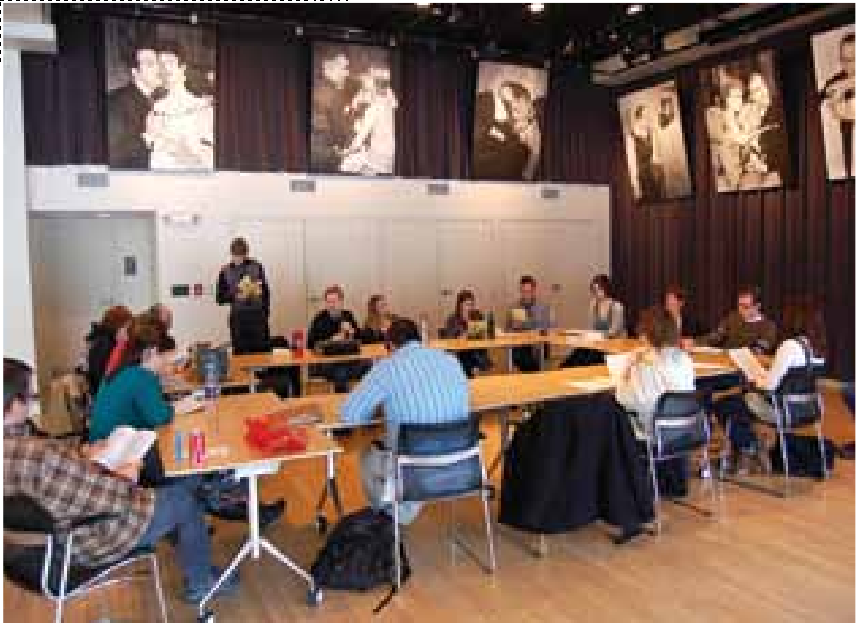Lower Marsh is a short little street along the southern side of Waterloo Station in Lambeth North. The street is anchored at each end by a Gregg’s Bakery, which seem to proliferate here like Starbucks does… everywhere. The entire north side of the street has patches marked out on it which are rented by street vendors of all sorts.
When we first got here, not knowing which flat to ring, and having no signal for our mobile phones, a gent, Ian, staffing the Wallabooks stall across the path from our door, offered to call for us, and has been a friendly face on the street ever since. There is food of all kinds – Mexican, Moroccan, Indian, etc. – as well as clothes, linens, miscellany. Every day the vendors start setting up early, many of the food vendors actually cook in the stall, having brought raw ingredients, or those slightly prepped. There are grocers set up at each end, near the Gregg’s shops.
We chose, today, to head over to Tate Modern for Yayoi Kusama. We walked over to Southwark along Southbank and Bankside, passed the tourist shrines of The Clink and The Golden Hinde. Tate Modern is in an old power plant (arts centres are a common re-use of these facilities) looming large on Southbank across from St. Paul’s majestic presence.
The show itself was a bit of a disappointment. We knew little about Kusama going in, but the Guardian had raved about the show, so we took it on faith. In brief, her work is compulsive, obsessive, derivative and in some ways exploitative. Kusama herself suffers from mental illness, and has most of her adult life. Inspired by the Pop-Art movement in the 1960s, she took her obsessive works, her “Infinity Net†series and parleyed that into fame through a series of very out, sexually expressive be-in type events: Kusama’s Self Obliteration.
Her sculptural works involve the application of thousands of fabric phalli attached to everything from row boats to couches, suitcases, tunics, shelves… Or macaroni, she liked to stick that to everything in sight, too. Hmm.
Her whole room installation pieces are the most successful in my eyes. She toyed with “Infinity Rooms†of various type, including one filled with typical living room objects – telly, couch, coffee table, lamps – yet covered with the little round day-glow stickers of the type used to tag goods in a tag sale. The whole room is then bathed in black-light. In another of the rooms, lights of varying colour are suspended in chains from the ceiling all around you, as you tread a reflective path between pools of water, surrounded by walls of mirror. The whole effect is quite pleasant and disorienting.
Well, enough of that. Famished, we headed next further down-river to Borough Market where our pockets were thoroughly picked by the various floggers of food all about. We sampled and bought with reckless abandon, coming back to the flat with a lovely Norfolk Hen, humongous baking potatoes, fresh cut sage, garlic, cheeses, prosciutto, cookies, and some of the most pungent licorice you will ever find. (“It’s okay, feel free to spit it out. I’ve seen that plenty.†said the candy seller to the woman who took a sample after I exclaimed how good it was.)
Back at the flat, X cooked up the hen, roasted a tater (one was big enough for two) and I dealt with salad and Brussels sprouts. Oh, what a feast had we! Yowser!!
A little wine with dinner, then off we stumbled down Lower Marsh street to the well hidden entrance to the Old Vic Tunnels, where we were to see The Sea Plays, by Eugene O’Neill. The tunnels are 30,000 square feet of abandoned rail tunnels, storage vaults, and drainage caverns underneath the Waterloo Station. Vast dank catacombs, sprawling for acres. We found a perch in the bar, on an old overstuffed, and waited patiently. Suddenly a team of firemen marched through the crowd. Not fire-engine and dalmatian type firemen, no the men who stoke the fire of a steam driven ship.
Soon, a bell, and we follow down a dark corridor towards the engine room of the ship. The air is acrid and dense with smoke. Bright orange and red light flashes from the great maw of the fireboxes as the men, streaked with sweat, shovel coal into them. The sharp clank-clank of the engine’s fills the air. We’re shepherded further into the ship, till we left gazing into the main hold, a calm night, just some fog in the air.
A sudden lurch signals the arrival of heavy weather, and the entire ship lunges first to one side then the other. Duct work swings down from the rafters as great washes of waves break over the sides of the ship, scuppering the gun’lls. We see a man washed into the hold, tumbling the vast distance from the deck ’till he disappears from view into the dark depths. There are the cries of his fellow sailors as they struggle to rescue him.
Finally, the storm subsides and we’re left in the fo’c’s’le, the men in their bunks, but one lies alone, on a stretcher. He is tended to by his friend and fellow seaman…
That is how dramatic our introduction was to O’Neill’s 1916 masterpiece, Bound East For Cardiff, and it never let up for a moment. The staging was nothing short of brilliant, the acting roundly good, the production values exceptional and the entire experience left the audience gasping for breath, holding onto our seats, and utterly absorbed into the experience of the show. Wow!
Cannot really pick out any particular performance here. It was a tight ensemble of 16 actors for the three pieces. The first act, in addition to Bound included In The Zone, a taught drama involving men on a merchant vessel trying to avoid U Boats during WWII. Act 2 brought The Long Voyage Home, set at port, where just-paid sailors try to find some R&R in a port of call, and some try to escape the sea at last.
One might ask, but what about the inevitable noise form the working station up above? Well, for this show at least, it is an ever-present but not at all distracting or out of place sonic accompaniment.
We’ll be back to the Tunnels once more this trip. Silent Opera perform La Bohème next week, and we have tickets. Can’t wait!







